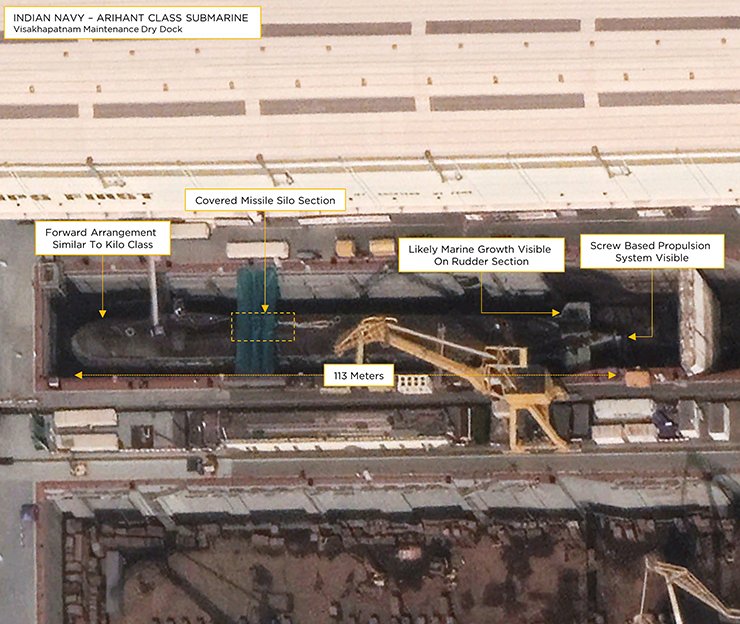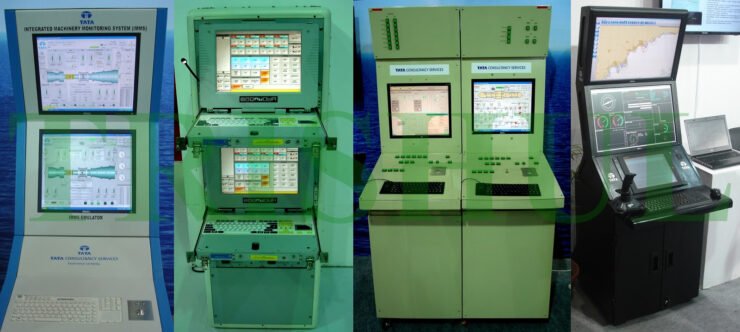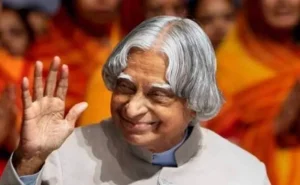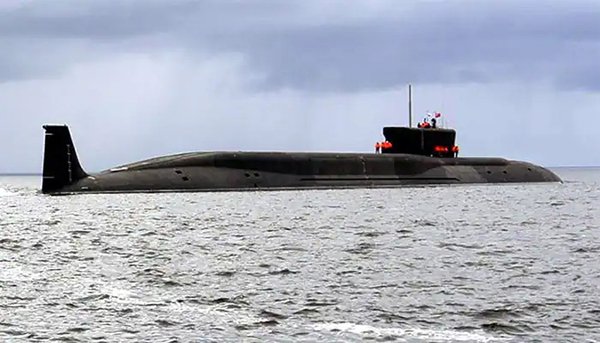The Arighat, like its predecessor, the 6,400-ton Arihant commissioned in 2016, and made operational in 2018 was built at the Ship Building Centre (SBC) in a Public Private Partnership (PPP) with Larsen & Toubro Ltd (L&T), which has experience in the construction and commissioning of India’s nuclear plants and makes reactors for the oil and gas industry at Hazira at its engineering facilities. L&T fabricates submarine sections and transports them to the SBC.
The SBC is a restricted nuclear submarine base with berthing facilities and a finger jetty next to the Naval Dockyard. It has a big ship-building shed, atomic safety systems, and support facilities, such as water, electricity, and air conditioning supplies for nuclear submarines, to keep the reactor or generators from running in the harbour.
The Ministry of Defence (MOD) stated it had made improvements in Arighat from experience gained from operating INS Arihant, which was successfully commissioned and run with an 83 MW plutonium pressure light water nuclear reactor (PWR) supplied by the Bhabha Atomic Research Centre (BARC) under the Department of Atomic Energy (DAE).
In 1983, the Defence and Research Development Organisation (DRDO) set up the Advanced Technology Vessel Project (ATV) with Soviet help under retired Vice Admiral MK Roy and later Vice Admiral Bharat Bhushan. Arihant was planned as a ‘baby step’ nuclear submarine demonstrator.

INS Arihant evolved into a small SSBN as plans progressed when DRDO’s underwater-launched atomic missiles from a pontoon became available. A plug of 8/12 vertical launched 750 km K-15/B-05(Kalam Bhasin) nuclear-tipped missiles with GPS homing warheads. Arihant also carries 21-inch circumference torpedoes for self-defense.
Arighat’s weapon fit has rightly not been disclosed, though media has been speculating that DRDO has tested longer-range K-4 missiles from underwater platforms. An additional nuclear submarine base that is more extensive and significant than the SBC is being built under Project Varsha, south of Visakhapatnam. This will also help de-congest the harbour of Vishakhapatnam, where the Eastern Fleet, the Deep Submersible Research Vessel (DSRV) and submarines are based.
Submarines are pear-shaped, and propel faster underwater than on the surface, and are weapons of war as predators. During peace, they are used for intelligence-gathering and anti-submarine training for ships and aircraft.

As per nomenclature, conventional submarines run on diesel engines on the surface and charge batteries to power electric motors for limited underwater propulsion. They are equipped with missiles to attack ships and land targets, and they are equipped with torpedoes to attack submarines, which are called submarine hunters (SSK).
They are quieter when operating on battery power but need to surface periodically to recharge the batteries. That is when they are most vulnerable to attack by ships and aircraft. The Indian Navy has fifteen conventional submarines with Klub, SM39 Exocet, and reportedly Harpoon missiles.
The newer conventional submarines have air-independent propulsion (AIP) with cells like hydrogen and oxygen for extended underwater propulsion. They are called “the poor Navy’s nuclear submarines”.
The Indian Navy has plans to retrofit AIP in its conventional submarines when they come in for long refits. Pakistan’s French-supplied and locally built Agosta submarines have a MESMA (Module d’EnergieSous-Marin Autonome) air-independent propulsion (AIP) system and SM39 missiles.

The second type of submarine is the submerged ship nuclear submarine (SSN), which is nuclear-propelled to stay underwater for days and carry conventional ship and land attack missiles and torpedoes.
India leased the 671 K-43 Nerpa from 1988-91 and an Akula II Class 871 Submarine in 2011 from Russia. both christened INS Chakra. The Navy became proficient in operating the nuclear-propelled submarines in exercises by the Navy’s Eastern and Western fleets on both coasts. Before being returned, they had clocked thousands of hours of reactor operations and many Amethyst missile and torpedo firings.
The SSBNs are larger submarines with long-range, powerful Kilo-ton underwater-launched nuclear missiles (SLBMs) for strategic nuclear deterrence and second strike in India’s No First Use nuclear policy.

Worldwide, SSBNs are manned by the Navy but controlled by the head of the nation or political leadership with a chain of command to give orders to the submarine Captain to be ‘ready for launch’ and, if necessary, ‘to launch nuclear missiles’ in a second strike.
They can engage enemy assets with great speed, precision, and lethality. Cruise Missile Submarines (SSGNs) are modified SSBNs or specially designed submarines equipped with cruise missiles for long-range attacks on inland targets.
The USA used Tomahawk cruise missiles to attack Afghanistan in the War on Terror. Russia has used 1,000 km Kalbir missiles to attack US-supported bases in Syria and liberally in the Ukraine war.
India’s two SSBNs are built under the DRDO’s ATV project, now called Akanksha (hope). The projects are executed under Indian naval supervision by a technical director general.
The ATV has a Defence Machinery Development Establishment (DMDE) at Hyderabad with a director and naval and civilian staff who operate test beds to clear machinery before it is installed in nuclear submarines and ships.
The submarines must have zero breakdown systems. The Machinery Trials Centre (MTC) at Vishakhapatnam also contributes to testing smaller systems.
SSBNs, also called ‘boomers,’ can remain underwater as long as the food stocks last, making their detection challenging. In November 2018, Prime Minister Narendra Modi personally received Arihant’s Captain and crew at Vishakhapatnam in a closed-door session after her first war-like extended operational patrol to congratulate them and announced to the world that India had a strategic asset to serve as an undetectable launch platform for submarine-launched nuclear ballistic missiles.

This patrol must have included a missile drill with codes sent from the Prime Minister’s computer or repository (the US calls it the football that the POTUS carries) through the National Security Adviser (NSA), National Security Council and the Strategic Forces Commander (SFC) to the submarine’s Commanding Officer through communication checks.
A land-based nuclear reactor with a half-submarine propulsion system as a test bed was set up in the 1980s at the Indira Gandhi Centre for Atomic Research (IGCAR) Kalpakam and is now utilised for training.
It is referred to as S-1. Arihant is S-2, Arighat is S-3, and S-4 is reportedly in an advanced stage, and a bigger S-5 is being designed. In February 2015, the Defence Acquisition Council (DAC) in MOD approved the construction of six nuclear-powered attack submarines (SSNs) for the Indian Navy in India as the capability and eco-system for construction was built up.

Underwater launch tests of the BrahMos missile had succeeded. This was a dream of the late President Dr Abdul Kalam. Still, for unknown reasons, the proposal never moved, and two SSNs are being considered.
Notwithstanding the lack of an apparent threat perception or strategy by the Leadership to plan submarines, the credit goes to the leadership of the Navy, DRDO, DAE, and industry, including their technical and design cadres, which continue their commitment to self–reliance or Aatmanirbharta with fewer imports.
However, the navy cannot rest on its laurels as India has several security challenges ahead, with two wars raging in Europe and the Middle East and between our friends.

The Navy’s field units in the shipyards, Naval dockyards, and industry need to strengthen further to improve construction timelines and audit costs more in PSUs, which keep getting away with cost overruns. PSUs’ staff levels also need appraisal as modern techniques and Artificial Intelligence are being introduced.
In conclusion, one must pay credit to the efforts of Dr Abdul Kalam, VS Arunachalam and VK Atre as DRDO heads to support this ATV, a truly Aatmanirbharta project, but also to meet with China’s large fifty conventional and nine nuclear submarine forces and three aircraft carriers.

The Indian Navy must lobby for at least four SSNs and another aircraft carrier in its Order of Battle (ORBAT) in the next two decades to become a truly Blue Water Force.
SSNs and aircraft carriers are long-term projects. With a little fillip of small additional annual cost, the Navy’s budget can accomplish this as it accomplished INS Vikrant as a challenge by the Prime Minister.
Shaṁ No Varunaḥ!
-The writer is a former DNO and DNI, who writes and has authored books on Naval affairs and curates a Maritime Museum at C 443 Defence Colony, New Delhi 110024. Views are personal and not attributable to the Indian Navy or DRDO or attributable to Raksha Anirveda.
The writer is a naval author and curates a Maritime Museum at C 443 Defence Colony, New Delhi and writes and lectures on maritime issues.






